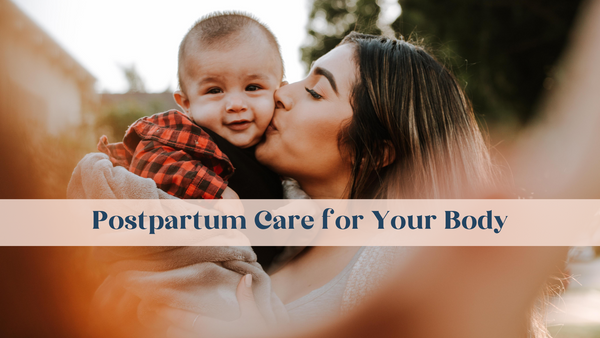Postpartum Care for Your Body
Whether you’re a first-time parent or are welcoming more little ones into your family, the transition to life after baby is always full of excitement, challenges, and unknowns. And while we, as a society, are eager to celebrate new births (as we should be!), we often underestimate how long it truly takes and what it looks like for new parents to recover from the birthing process.
Postpartum recovery should be measured in months, not weeks, and there is no one-size-fits-all best approach to taking care of yourself after the birth of your baby. Each person’s experience is unique, but there are some commonalities that many people will share. To help us all feel more connected and empowered in our postpartum journeys, today we’re highlighting a few of the ways we can care for ourselves physically and emotionally after the births of our babies.

Say “no” if you’d like to, ask for help, and give yourself some grace.
With all the big changes that occur, it can be helpful to remember that one of the most caring things you can do for yourself and your baby is to be mindful of your mental and emotional health. After childbirth, it’s very common and quite normal for birthing parents to experience “baby blues”, which can present itself in a variety of ways, including mood changes, anxiety, and crying. During the first few days and weeks with your baby, you may not feel like yourself–and that’s completely understandable! You’ve just gone through what is most likely one of the most life-changing events you’ll ever experience. Know that it’s always okay to ask for help or say no to anything that feels overwhelming (including accepting visitors).
Taking some time to learn about the differences between baby blues and postpartum depression can be a great first step to help yourself or someone else who may be struggling after giving birth. There is always hope, and there are many great treatment options and resources to help those who are affected by postpartum depression, including Postpartum Support International and The Center for Women’s Mental Health at Massachusetts General Hospital.
Move slowly, and only when you’re ready.
We believe that you know your body best, and no one else can tell you what feels right or wrong when it comes to introducing exercise after giving birth. Your healthcare provider can help guide you as you bring movement back into your lifestyle, and it’s important to only move in ways that feel safe for you and your body. If you’re curious to see an example of some general guidelines that your provider might recommend, take a look at this Pelvic Floor PT’s guide to exercise & movement during the first few weeks postpartum.

Take care of your pelvic floor health
Whether a person delivers their baby vaginally or through C-section, their pelvic floor muscles and organs endure a lot of stress during pregnancy and birth. As a result, many people experience changes to their bladder and/or bowel function following delivery. Sometimes, these changes are noticeable immediately, and sometimes they appear after weeks or months. Some postpartum pelvic floor symptoms may resolve on their own, and others may improve with treatment recommended by a healthcare provider.
One technique that has been shown to help people with some of their postpartum bowel symptoms is diaphragmatic breathing, also known as “belly breathing.” This can be a gentle way to bring movement back into your life and rebuild strength in your pelvic floor muscles. “With breath,” says Brooke Cates, a prenatal and postnatal exercise specialist, “you begin the healing process postpartum by simultaneously rehabbing both the deep core and the pelvic floor. Being able to ‘just breathe’ in the early days postpartum also allows you to truly honor your body and your current experiences.”

And that, we believe, is what the postpartum period should be all about: honoring you, your body, your baby, and your experience.
**Medical Disclaimer: This post is intended to provide information and resources only. This post or the information contained within should not be used as a substitute for professional diagnosis, treatment, or advice. Always seek the guidance of your qualified healthcare provider with any questions you may have regarding your healthcare, conditions, and recommended treatment.

